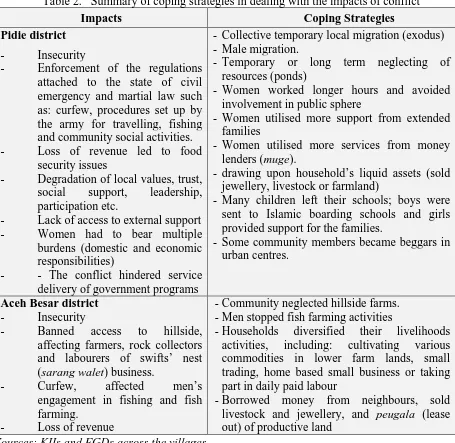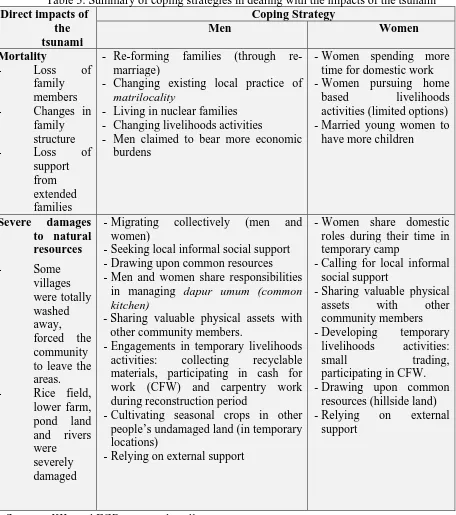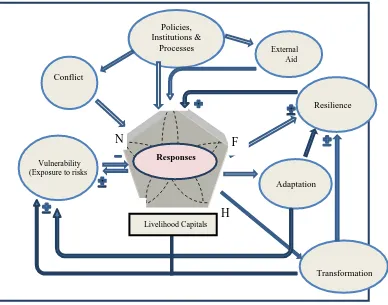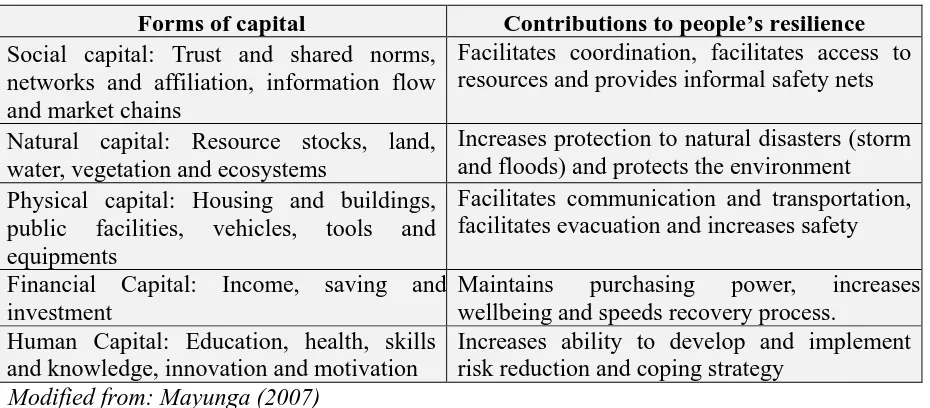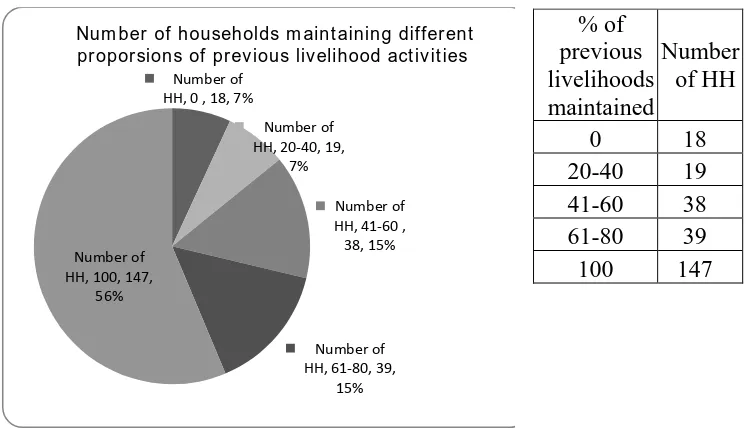313
BUILDING RESILIENCE OF LIVELIHOOD SYSTEMS TO DISASTER:
LESSONS LEARNED FROM THE TSUNAMI DISASTER RECOVERY
PROCESS
WARDAH HASYIM
1PhD candidate at Natural Resources Institute, University of Greenwich UK Medway
Campus, Central Avenue, Chatham Maritime, Kent, ME4 4TB, UK.
1Lecturer at Agriculture Faculty, the University of Iskandar Muda, Banda Aceh, Indonesia.
Email: [email protected]
ABSTRACT
This research aimed to assess the contribution of livelihood recovery efforts, including communities’ own initiatives and external support, to people’s livelihoods in the tsunami-affected areas in Aceh Province, Indonesia. Using a mixed-methods approach and covering fourteen tsunami-affected villages located in Pidie and Aceh Besar district, the study adopts the concept of Sustainable Livelihoods and modifies the Sustainable Livelihoods Framework (SLF) for its critical analysis. The findings show that people’s strategies were influenced by local values, practices and institutions, previous hardships, and contributions from different livelihoods recovery programmes implemented by relief and development agencies. In dealing with the impacts of the tsunami, men and women in the affected communities showed various short-term responses or coping strategies. For longer term recovery, communities developed adaptation and transformation strategies for their livelihood activities. In many cases, people adjusted existing livelihood activities to the changes as well as developing new livelihood strategies. This led to different outcomes for households, either being more resilient or more vulnerable, as well as influencing their future access to assets.
Keywords: Disaster, Livelihoods, Resilience, and Sustainable Livelihoods.
Introduction
The tsunami disaster in 2004 affected a huge number of people and their livelihoods in Aceh Province, Indonesia. The World Bank reported that the livelihoods of people in the agriculture and fisheries sectors were the hardest hit, with damage to productive assets and loss of income estimated at over one-third of the total losses due to the disaster. This led relief and development agencies to invest major support in livelihoods recovery post-tsunami.
314 known as livelihood programming. In this regard, relief and development agencies adopted different approaches.
Scoones (1998) asserts that livelihood adaptation, vulnerability and resilience are central to the definition of sustainable livelihoods. Davies (1996) considers that such resilience in facing stresses and shocks is a key to both coping and livelihood adaptation. According to Scoones (1998), assessing resilience and the ability to positively adapt or successfully cope requires analysis of a range of factors, including an evaluation of historical experiences of responses to various shocks and stress adaptation strategies.The aim of this paper is to present how livelihood recovery efforts, both through communities’ own initiatives and external support, contributed to rebuilding people’s livelihoods after the tsunami.
Study area and Methods
Research was conducted in four villages in Pidie district, located in Kembang Tanjong and Bate sub-district, and 10 villages in Aceh Besar, located in Lhoknga, Leupung and Lhoong sub-district. Villages were selected according to three main criteria - the type of livelihoods programme intervention, the presence and intensity of conflict and physical accessibility. The study adopted a mixed-methods approach, combining quantitative and qualitative research. Qualitative techniques included key informant interviews (KIIs), mixed-group and gender-disaggregated focus mixed-group discussions (FGDs), case studies and participant observation. Quantitative data was obtained through household surveys.
Results and Discussion
Pre-event vulnerability and people’s coping strategies
The major livelihood activities prior to the tsunami are listed in Table 1.
Table 1. Men’s and women’s livelihoods activities in the study areas prior to the tsunami
Men’s livelihoods Women’s livelihoods
Pidie district
Fishing (sea and river), fish farming, small/market trading, raising livestock (goat)
Making mats, producing salt, collecting oysters, raising small livestock (duck and chicken) and small trading
Aceh Besar district
Farming (rice, seasonal crops and perennial trees), fishing (sea and river), fish farming, raising livestock (buffalo, cow and goat), collecting rock, daily paid labour, small trading and carpentry
Farming (rice, seasonal crops and perennial trees), collecting oyster, collecting sand, producing salt, raising small livestock (duck and chicken), small scale home based business (making cake, traditional spices and tailoring), small trading and daily paid labour
Sources: Summaries from FGDs and KIIs.
315 Table 2. Summary of coping strategies in dealing with the impacts of conflict
Impacts Coping Strategies
Pidie district
- Insecurity
- Enforcement of the regulations
attached to the state of civil emergency and martial law such as: curfew, procedures set up by the army for travelling, fishing and community social activities.
- Loss of revenue led to food
security issues
- Degradation of local values, trust, social support, leadership, participation etc.
- Lack of access to external support
- Women had to bear multiple
burdens (domestic and economic responsibilities)
- - The conflict hindered service
delivery of government programs
- Collective temporary local migration (exodus) - Male migration.
- Temporary or long term neglecting of resources (ponds)
- Women worked longer hours and avoided involvement in public sphere
- Women utilised more support from extended families
- Women utilised more services from money lenders (muge).
- drawing upon household’s liquid assets (sold jewellery, livestock or farmland)
- Many children left their schools; boys were sent to Islamic boarding schools and girls provided support for the families.
- Some community members became beggars in urban centres.
Aceh Besar district
- Insecurity
- Banned access to hillside,
affecting farmers, rock collectors and labourers of swifts’ nest (sarang walet) business.
- Curfew, affected men’s
engagement in fishing and fish farming.
- Loss of revenue
- Community neglected hillside farms. - Men stopped fish farming activities
- Households diversified their livelihoods activities, including: cultivating various commodities in lower farm lands, small trading, home based small business or taking part in daily paid labour
- Borrowed money from neighbours, sold livestock and jewellery, and peugala (lease out) of productive land
Sources: KIIs and FGDs across the villages
The impacts of the tsunami on men’s and women’s livelihoods and coping strategy
316 Table 3. Summary of coping strategies in dealing with the impacts of the tsunami Direct impacts of
the
- Re-forming families (through re-marriage)
- Changing existing local practice of matrilocality
- Living in nuclear families - Changing livelihoods activities
- Men claimed to bear more economic burdens
- Women spending more time for domestic work - Women pursuing home
based livelihoods activities (limited options)
- Married young women to have more children
Severe damages
- Migrating collectively (men and women)
- Seeking local informal social support - Drawing upon common resources - Men and women share responsibilities
in managing dapur umum (common kitchen)
- Sharing valuable physical assets with other community members.
- Engagements in temporary livelihoods activities: collecting recyclable materials, participating in cash for work (CFW) and carpentry work during reconstruction period
- Cultivating seasonal crops in other people’s undamaged land (in temporary locations)
- Relying on external support
- Women share domestic roles during their time in temporary camp
- Calling for local informal social support
- Sharing valuable physical assets with other community members
- Developing temporary livelihoods activities:
small trading, participating in CFW.
- Drawing upon common resources (hillside land) - Relying on external
support
Sources: KIIs and FGDs across the villages
317 valuable source of motivation. This helped the community members to keep hope for their future. A sense of responsibility and hard work, sincerity and their experiences in facing previous hardship played an important role in gaining motivation for recovery.
However, as the impact of the tsunami disaster on people’s livelihoods was overwhelming and unprecedented, especially the severe damage to physical capital and loss of households’ assets, it was beyond the ability of the affected community to cope by using only their own resources. Therefore, the role of external support was extremely important. The delivery of external aid and recovery process were positively influenced by significant improvement in security, since a peace agreement between the Indonesian government and The Aceh Free Movement (rebel group) was signed within the first year after the disaster. The livelihood recovery process and outcome after the tsunami in the study area can be explained through the following conceptual framework:
Figure 1. Conceptual framework of livelihood recovery process and outcomes
Figure 1 shows that access to various livelihood capitals in a post disaster situation is influenced by the degree of shocks (vulnerability context), policies, institutions and processes as well as external aid. This access determines their immediate responses (coping mechanisms) and their further adaptation and transformation strategy, which in turn will result in different outcomes for households, either being more resilient or more vulnerable, as well as influencing their future access to assets. Each livelihood capital contributes to the system’s resilience in various ways, as presented in Table 4.
Resilience
Vulnerability (Exposure to risks)
Transformation H
N F
External Aid
Policies, Institutions &
Processes
Conflict
Adaptation
Livelihood Capitals
318 Table 4. The relationship between livelihood capitals and community resilience
Forms of capital Contributions to people’s resilience
Social capital: Trust and shared norms, networks and affiliation, information flow and market chains
Facilitates coordination, facilitates access to resources and provides informal safety nets
Natural capital: Resource stocks, land, water, vegetation and ecosystems
Increases protection to natural disasters (storm and floods) and protects the environment Physical capital: Housing and buildings,
public facilities, vehicles, tools and equipments
Facilitates communication and transportation, facilitates evacuation and increases safety
Financial Capital: Income, saving and investment
Maintains purchasing power, increases wellbeing and speeds recovery process.
Human Capital: Education, health, skills and knowledge, innovation and motivation
Increases ability to develop and implement risk reduction and coping strategy
Modified from: Mayunga (2007)
The role of external aid in livelihoods recovery
Massive destruction of livelihoods capitals and loss of income was the main reason why relief and development agencies invested major support in livelihoods recovery after the tsunami. Four livelihoods programmes in the area were selected for the study and their contributions to people’s livelihoods were assessed based on the beneficiaries’ perspectives. The programmes were: (1) Cash transfer, implemented by the Asian Development Bank, (2) Community revolving funds, implemented by PASKA, (3) Women’s livelihoods support, implemented by PASKA, and (4) In-kind assets transfer, which includes the rice field rehabilitation programme implemented by the Department of Agriculture, and an agro input programme for ginger cultivation complemented by skill training delivered by the Lam Reneu Foundation.
This external aid, which enhanced household access to livelihoods capitals, and interplayed with people’s own motivation and social values, has contributed to the process of livelihoods recovery. In many cases it was the foundation for each household to develop their livelihood strategies after the tsunami, which could be: (a) similar to their pre-tsunami livelihood activities, (b) improving existing activities (adaptation strategy), or (c) developing new livelihood activities (transformation strategy). The household survey provided evidence of the changes in people’s livelihoods activities.
319 Figure 2. Number of household maintaining pre-tsunami livelihood activities
Table 5. Adoption of new practices into existing livelihoods activities
Previous status of livelihoods
activities
New adaptations Drivers Outcomes
Rain-fed such as tractor and thresher, using
The promotion of
agriculture intensification introduced by the
Department of Agriculture. The institution assisted the communities with land rehabilitation programme which was combined with distribution of free agro-inputs.
- In rain-fed farming system, the
use of highly-yielding seed, with shorter life span but more susceptible to draught and flood, resulting in uncertainty of outcomes.
- A shorter life span, has made
multiple cultivation in a year possible. This has been the main reason for the sparrow (Lonchura leucogastra) outbreak in the area. This was also a result of the fact that some farming areas were neglected and reverted to bushland after the tsunami. This provides secure nesting areas for the birds
- The sparrow outbreak, as a new
form of environmental stress has forced women to invest more time on the farm in dealing with invasions of sparrows.
Women’s activities in collecting
Adopting new oyster cultivation techniques and a
PASKA’s Women
support programme - Sustainable use of resources with a better quality of oysters produced in a more predictable
320
new institution in accessing the river as a common resource.
quantity.
- A new institution adopted in
regulating households access to common resource (river)
- A more sustainable, predictable
and better households’ (women’s) income
Using a modified model of stove that facilitates a quicker boiling process.
PASKA’s Women support programme
- A quicker process reduces
women’s working hours and increases productivity.
- A more efficient use of
resources (firewood) implies less capital required for production.
- This does not always a
guarantee for a better income. Women in this village claimed that this activity is heavily affected by seasonality and they still have salt price issue in the same time. The productivity is lower during the raining season than the dried season, yet the price is fluctuated in opposite way; it has higher value during the raining season. using highly yield seeds and
fertilizers.
Lam Reuneu
Foundation’s livelihoods recovery programme provided in-kind assets transfer and skills trainings.
- A better quality and a higher
quantity of harvest contribute to a better income for the households.
- Many young men from
land-less families cultivate ginger in other people’s land by
following mawah (share
cropping) system. This does not
only reduce unemployment but also increases households’ income and improves the use of lower farm land.
Being
Forming a village cooperative which
revolving fund approach, and providing two big boats for both
communities.
- Women participation in
321
Guenteng Timu village)
positive changes for women in the area.
- Mutual trust and equal right in
accessing the services among the cooperative members have contributed to a stronger social connectedness.
- The cooperative services
promote a better income for both men and women and this reduces women’s economic burden.
- A groups of 10-15 men in each
village is using the boat for fishing activities.
Conclusions
Livelihoods recovery processes and outcomes have been influenced by a number of factors. People’s own capability to cope with the impacts of disaster was influenced by their motivations and social values and practices, and was complemented by external aid and a conducive political environment. These influence people access to assets, which in turn determined their short term responses and long term adaptation and transformation strategy. This leads to both possibilities of their being more resilient or more vulnerable, as well as influences their future access to assets.
The findings show that a resilient livelihoods system does not mean that the system has the ability to bounce back to its previous status in a linear process. In actual fact, this involved changes in people’s access to different levels and combinations of assets, which led to a new livelihoods transformation or adaption of existing livelihoods to changes. Therefore, in this context, being resilient should be looked as the ability to respond, manage and mobilise the assets, and use the opportunity to move on.
Practical lessons and policy implications
The findings of this study offer some practical lessons and policy implications as follows:
1. In delivering livelihoods recovery programmes, it is important for relief and development agencies as well as government institutions, to take into account any pre-event status (previous hardships and sources of resilience) of the affected community. This will allow recovery efforts to be used as a window for opportunity to build a better and more resilient and sustainable livelihoods systems, instead of rebuilding pre-event risk and vulnerabilities or investing in a greater future risk and vulnerabilities.
2. The Sustainable Livelihood concept suggests that people’s livelihoods strategy and outcomes are influenced by the vulnerability context, their access to livelihood capitals and policies, institutions and processes. Adopting this concept into a programme consequently requires an integrated approach instead of single sector approach.
322 agencies to adopt the concept of Sustainable Livelihoods in their programmes. This is a people-centred approach which enables parties to comprehensively assess people’s needs. It is goes beyond a conventional single-sector approach and potentially offers a more effective and efficient outcomes of livelihood programmes in a development and post-disaster setting.
Acknowledgements
This study was sponsored by Directorate of Higher Education, National Ministry of Education, the Republic of Indonesia. I would like to thanks my funding for sponsoring these studies and my supervisors for providing valuable guidance through this research. I also sincerely appreciate all the support provided by the Dean of Faculty of Agriculture and the Rector of University of Iskandar Muda, Banda Aceh.
References
Davies, S. (1996) Adaptable Livelihood: Coping with Food Insecurity in the Malian Sahel. Macmillan Press. Basingstoke.
DFID (1999). Sustainable Livelihoods Guidance Sheets.
http://www.efls.ca/webresources/DFID_Sustainable_livelihoods_guidance_sheet.pdf
